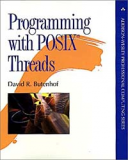Книга: Programming with POSIX® Threads
10.3 POSIX 1003.14
10.3 POSIX 1003.14
POSIX.14 is a different sort of standard, a "POSIX Standard profile." Unlike Pthreads and POSIX.1j, POSIX. 14 does not add any new capabilities to the POSIX family. Instead, it attempts to provide some order to the maze of options that faces implementors and users of POSIX.
The POSIX.14 specifies which POSIX optional behavior should be considered "required" for multiprocessor hardware systems. It also raises some of the minimum values defined for various POSIX limits. The POSIX.14 working group also
devised recommendations for additional POSIX interfaces based on the substantial multiprocessing and threading experience of the members. Many of the interfaces developed by POSIX. L4 have been included in the POSIX.1j draft standard.
Once POSIX.14 becomes a standard, in theory, producers of POSIX implementations will be able to claim conformance to POSIX.14. And those who wish to develop multithreaded applications may find it convenient to look for POSIX. 14 conformance rather than simply Pthreads conformance. (It remains to be seen whether vendors or users will actually do this, since experience with POSIX Standard Profiles is currently slight.)
The POSIX.14 working group also tried to address important issues such as these:
• Providing a way for threaded code to determine the number of active processors.
• Providing a way for threads to be "bound" onto physical processors.
• Providing a "processor management" command to control which processors are used by the system.
Although these capabilities are universally available in all multiprocessor systems of which the working group was aware, they were dropped from the standard because of many unresolved issues, including these:
• What good does it do to know how many processors there are, if you cannot tell how many your code may use at any time? Remember, the information can change while you are asking for it. What is really needed is a function asking the question "Would the current process benefit from creation of another thread?" We don't know how to answer that question, or how to provide enough information on all reasonable architectures that the application can answer it.
• How can we bind a thread to a processor across a wide range of multiprocessor architecture? On a nonuniform memory access system, for example, representing the processors as a uniform array of integer identifiers would be misleading and useless —- binding one thread to processor 0 and another closely cooperative thread to processor 1 might put them across a relatively slow communications port rather than on two processors sharing a bank of memory.
Eventually, some standards organization (possibly POSIX) will need to address these issues and develop portable interfaces. The folks who attempt this feat may find that they need to limit the scope of the standard to a field narrower than "systems on which people may wish to use threads."
- 9.1.6.1. Использование функций POSIX: wait() и waitpid()
- Posix
- 14.2.2. Блокировка POSIX: fcntl() и lockf()
- 12.6.2. Функции POSIX: random() и srandom()
- Восстановление в POSIX
- 2.1.1. Соглашения POSIX
- 2.3.3.2. Длинные опции в стиле POSIX
- 8.3.1. Стиль POSIX: statvfs() и fstatvfs()
- 9.1.3.1. POSIX против действительности
- 10.6. Сигналы POSIX
- 14.1. Выделение выровненной памяти: posix_memalign() и memalign()
- 9.1 POSIX1003.1c-1995 options




